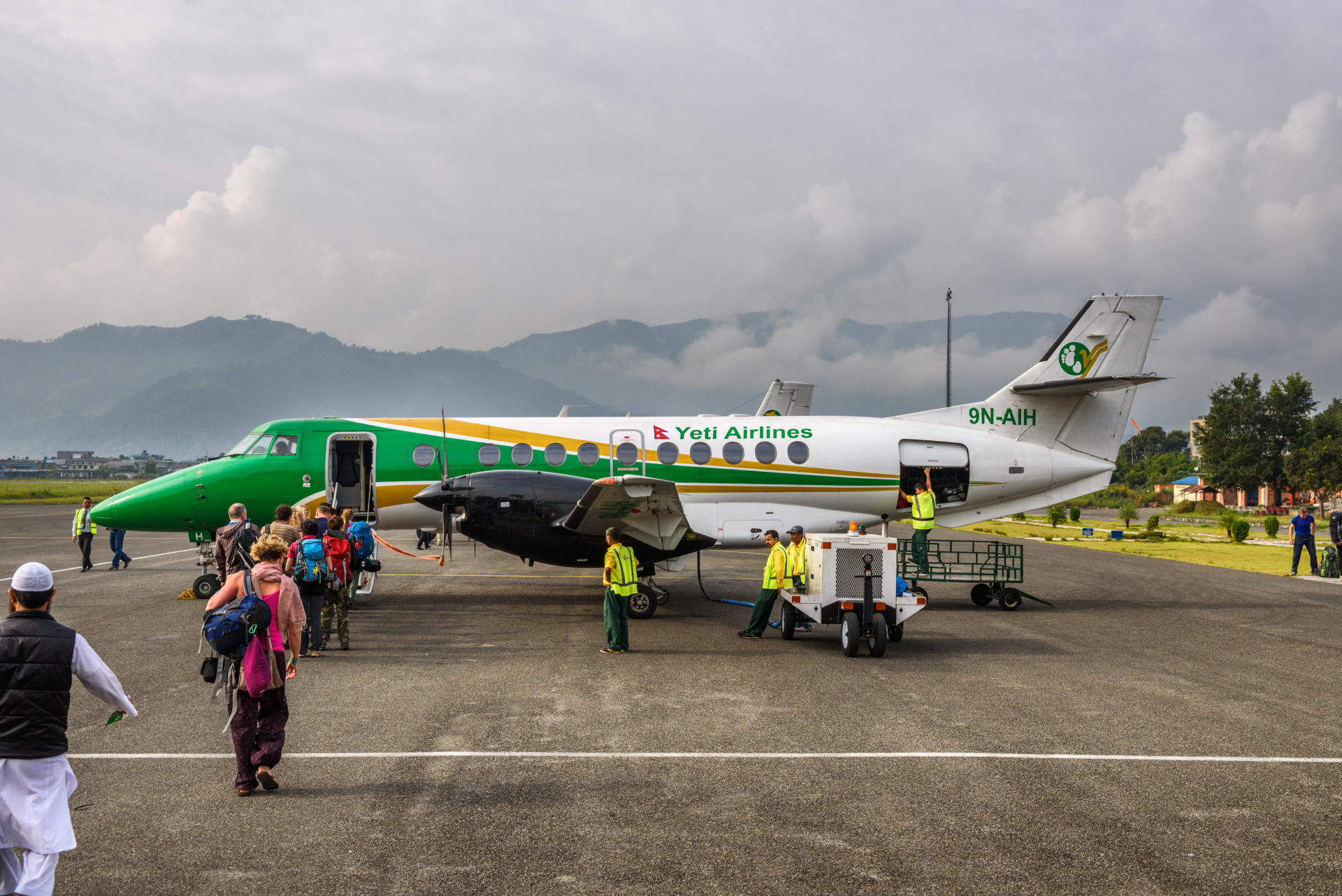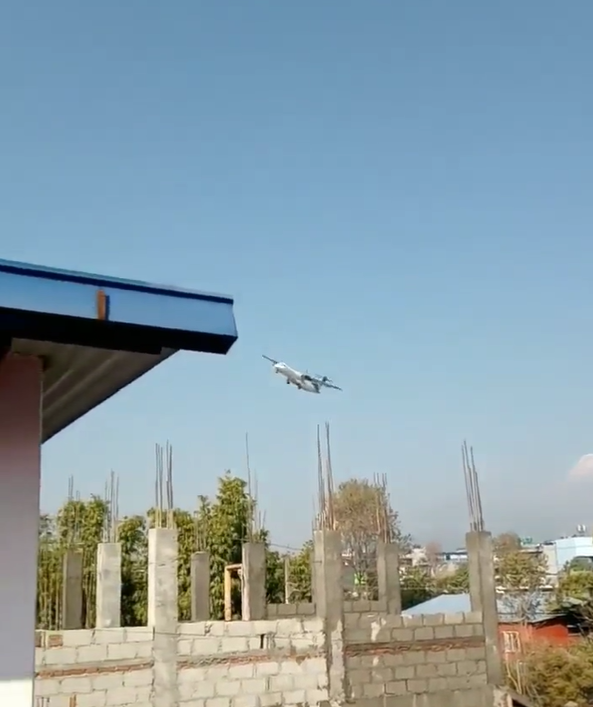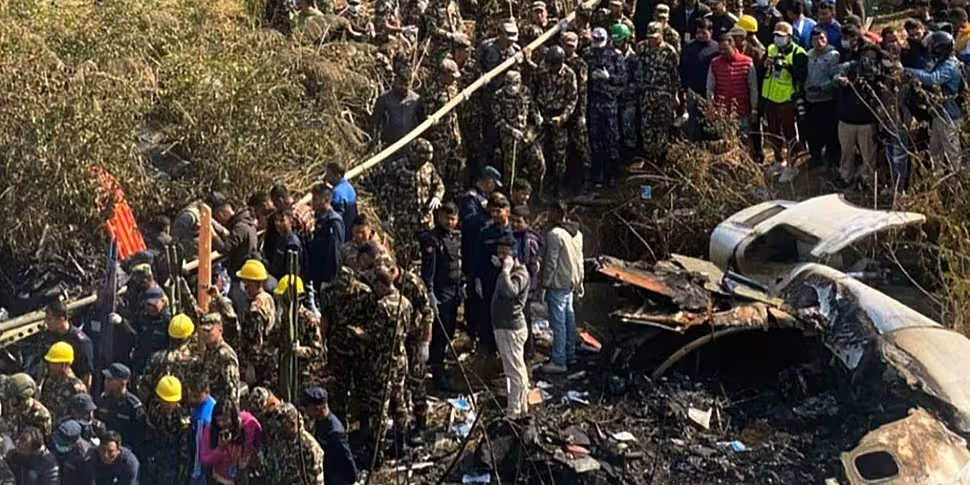Rescuers have resumed searching for four people still missing after Nepal's deadliest plane crash in 30 years, officials have said.
The ATR 72 aircraft, operated by Yeti Airlines, was carrying 72 people when it crashed in the tourist city of Pokhara minutes before landing in clear weather on Sunday.
Rescuers have so far recovered 68 bodies, with the black box and cockpit voice recorder having been found.
Nepal has declared Monday a day of mourning and has set up a panel to investigate the disaster and suggest measures to avoid such incidents in future.
It was not immediately clear what caused the accident.
The plane, on a scheduled flight from Nepal's capital Kathmandu, was carrying 57 Nepalis, five Indians, four Russians, two South Koreans, and one person each from Argentina, Australia, France and the UK.
A man - who was named as an Irish citizen by the Civil Aviation Authority of Nepal - is British, the Department of Foreign Affairs has confirmed.
Aviation journalist Gerry Byrne told Newstalk Breakfast the plane was just seconds from landing.
"The plane was just about to land, in fact it was probably 30 seconds to a minute away from the runway, when the pilots appear to have lost control and the plane crashed into a ravine not too far from the airport," he said.
"Unlike a lot of airfields in this part of the world, which are basically what one might call bush runways, this was quite a good airport.
"Well-tarmaced, fairly lengthy landing strip, so this was a good airport - although we don't know what kind of equipment it had installed."
Horrifying last moments of an ATR plane crash from Nepal in Pokhara that was bound for Kathmandu. All 72 people on board are dead. pic.twitter.com/4JZIvnThPQ
— Wajahat Kazmi (@KazmiWajahat) January 15, 2023
Mr Byrne said video footage circulating suggests the plane was out of control.
"[It] shows the aircraft obviously out of control," he said.
"Witnesses quoted by Reuters yesterday say the aircraft was rocking from side to side, which is fairly symptomatic of a stall.
"In other words, where the plane is losing lift and the pilots are therefore losing control.
"The video which came to light - a few seconds of the aircraft passing by the balcony of an apartment building - and it is dipping to one side, dipping to the left.
"We haven't seen what way it was dipping prior to it entering this manoeuvre, but the possibility is it was dipping to the right.
"That rocking motion is symptomatic of a stall - it is losing altitude.
"The nose appears to be up a little bit as though the pilot is trying to gain altitude, but the aircraft is still sinking.
"What has caused this is a big question.
"It could have been icing, it could have been tailwinds when the pilot was expecting headwinds... it could have been the aircraft was wrongly configured.
"The pilots may not have extended the flaps, for example, which extend the wing and allow it to keep aloft despite going more slowly as it approaches for landing."
'Do not appear to be survivors'
He said the plane broke in two when it crashed.
"There had unfortunately been a fire after the aircraft crashed," he said.
"The aircraft broke in two and one large piece of the aircraft fell over a small cliff into a river.
"It's a pretty nasty scene... there do not appear to be any survivors".
Nepal has a bad history when it comes to air disasters.
"It is one of the worst countries in the world, per head of population, for air crashes," Mr Byrne explained.
"There have been many, many air crashes - mostly of small aircraft.
"It had been barred from flying into the EU, the European Union had banned any Nepalese airline from flying into Europe, primarily because of the safety record," he added.
 People board a Yeti Airlines plane flying from Pokhara to Kathmandu in Nepal in this October 2015 file photo. Picture by: Nick Fox / Alamy Stock Photo
People board a Yeti Airlines plane flying from Pokhara to Kathmandu in Nepal in this October 2015 file photo. Picture by: Nick Fox / Alamy Stock PhotoAt the crash site near the Seti River, nearly two kilometres from Pokhara International Airport, rescuers sprayed fire hoses and heaved ropes down to another smouldering part of the wreck below.
The country's aviation authority said the plane last made contact with the airport from near Seti Gorge at 10.50am local time.
Nepal's Prime Minister Pushpa Kamal Dahal, who went to the airport after the crash, has set up a panel to investigate the accident.
"The incident was tragic. The full force of the Nepali army, police has been deployed for rescue," he said.
The type of plane involved has been used by several airlines around the world for short regional flights.
 Video on social media shows the Yeti Airlines plane moments before impact
Video on social media shows the Yeti Airlines plane moments before impactIntroduced in the late 1980s by a French and Italian partnership, the model has been involved in several fatal accidents over the years.
In 2018, an ATR 72 operated by Iran's Aseman Airlines crashed in a foggy, mountainous region, killing all 65 on board.
ATR identified the plane involved in Sunday's crash as an ATR 72-500 in a tweet.
According to plane tracking data from flightradar24.com, the aircraft was 15-years-old.
It was previously flown by India's Kingfisher Airlines and Thailand's Nok Air before Yeti took it over in 2019, according to records on Airfleets.net.
Yeti Airlines has a fleet of six ATR72-500 planes, company spokesman Sudarshan Bartaula said.
Sunday's crash was Nepal's deadliest since 1992, when all 167 people on board a Pakistan International Airlines plane were killed when it ploughed into a hill as it tried to land in Kathmandu.
Nearly 350 people have died since 2000 in plane or helicopter crashes in Nepal - home to eight of the world's 14 highest mountains, including Everest.
Additional reporting: IRN









